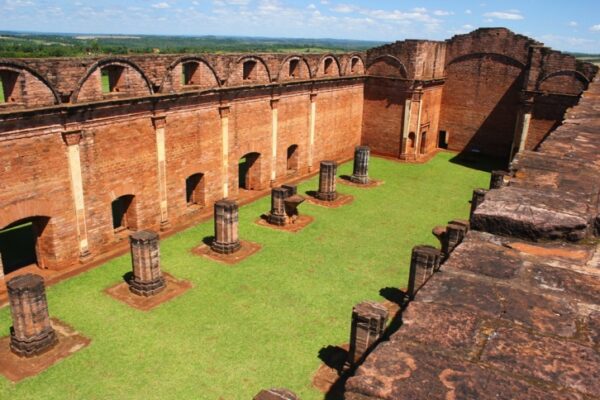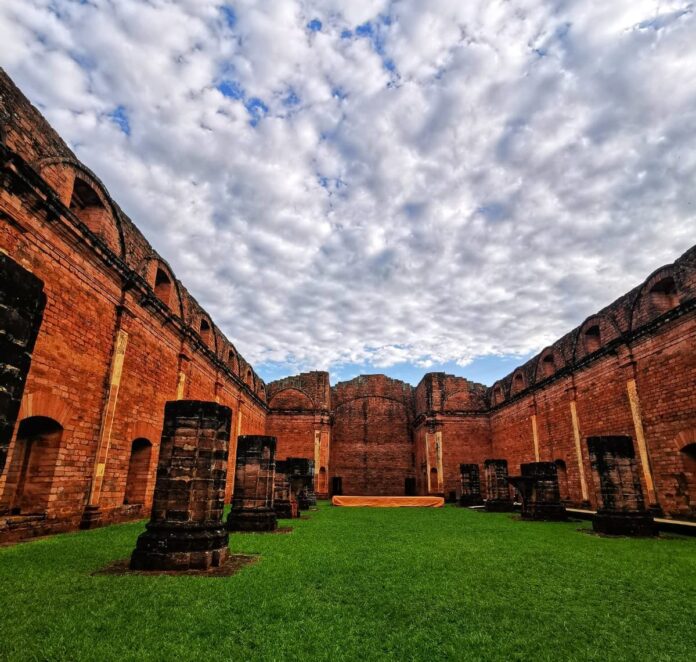Asunción, Agencia IP.- The mission of San Cosme and San Damián, built in the 18th century by Jesuits in the Itapúa department, seeks to be included on the UNESCO World Heritage list. It aims to keep alive a history that blends Indigenous beliefs with the scientific work of religious astronomer Buenaventura Suárez.
Named in honor of Cosme and Damián, two brothers and doctors canonized as saints, this mission, still surrounded by native houses and located along the Paraná River, neighbors the missions of Santísima Trinidad del Paraná and Jesús de Tavarangüé, both declared World Heritage Sites in 1993. Its history dates back to 1632 when it was first established in the Tapé mountains (Brazil), but it was in 1760 that it settled in what is now the town of San Cosme and San Damián.
«San Cosme is one of the 30 towns founded by the Society of Jesus, where Jesuit priests worked with the Guaraní over 300 years ago,» Lucas Vázquez, one of the site’s guides, told EFE, referring to settlements founded in what is now Argentina, Bolivia, Brazil, Chile, Paraguay, and Uruguay, collectively known as the «Thirty Towns.»
A joint effort
The Minister of the National Tourism Secretariat (Senatur) of Paraguay, Angie Duarte, told EFE that they hope to continue promoting this «unique Jesuit legacy, which is a source of pride for all Paraguayans,» with the inclusion of San Cosme and San Damián in the UNESCO list. «We are working with the Senatur team, in collaboration with other institutions, to achieve this nomination,» she said.
Duarte emphasized that securing this recognition would represent a «great commitment to the conservation of these sites» and serve as an incentive for tourism to Paraguay, which, though «not a beach destination,» is a place worth discovering.
A historical and cultural treasure
Itapúa is home to three Jesuit missions: Santísima Trinidad del Paraná, Jesús de Tavarangüé, and San Cosme and San Damián, all must-see destinations for visitors. Santísima Trinidad del Paraná, built in 1706 in Uruguay and relocated to Paraguayan land in 1712, spans eight hectares and contains the remnants of an urban center. Its main church is a baroque architectural gem with stone-carved decorations.
Also in Itapúa is the mission of Jesús de Tavarangüé, whose enormous temple is considered a replica of the Roman church of Loyola, though it was never completed due to the Jesuits’ expulsion.
Temple, school, and a clock
San Cosme and San Damián, smaller in size, boast a more preserved infrastructure, particularly its church, which houses the town’s main parish. Built with local stone and wood, the temple, 65.50 meters long and 12 meters wide, retains much of its original structure, though it has undergone various restorations.
 This mission includes two-story rooms once used as a cloister and school, as well as remains of a kitchen and even an aqueduct. But what truly makes this town special is the legacy of Buenaventura Suárez, a Jesuit born in Santa Fe de la Veracruz (now Argentina).
This mission includes two-story rooms once used as a cloister and school, as well as remains of a kitchen and even an aqueduct. But what truly makes this town special is the legacy of Buenaventura Suárez, a Jesuit born in Santa Fe de la Veracruz (now Argentina).
Mariela Cantero, responsible for this Jesuit mission on behalf of Senatur, told EFE that this site «was the first astronomical center in all of South America,» established by Suárez with the help of the Guaraní, with whom he built telescopes from bamboo and quartz stones mainly gathered from the Paraná River.
Suárez set up a telescope in the church’s bell tower. His observations were recorded in the Lunario de un Siglo (Lunar Calendar of a Century), first published in 1744, predicting the moon’s phases for the next 100 years. He also created the first map of the region and left behind a sundial that accurately marks wintertime.
Today, Suárez’s knowledge and the Guaraní beliefs are part of this mission’s tourist appeal. Guides like Katterin Leguiza tell how, nearly 300 years ago, a man in a cassock gazed at the stars. At the same time, the natives planned their harvests or interpreted their reality based on the constellations.

